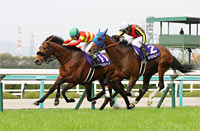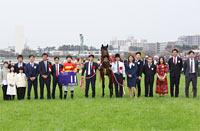2019 News
Osaka Hai (G1) - PreviewThis weekend, on Sunday, March 31, the main attraction switches from Nagoya’s Chukyo Racecourse to the Hanshin Racecourse west of Osaka for the 63rd running of the Osaka Hai. Only just elevated to the Grade 1 level in 2017, the race has been run over 2,000 meters of turf since 1972, when it was still a Grade 2 event and known as the Sankei Osaka Hai. It’s open to 4-year-olds and up, both male and female. This year, 15 horses have been nominated, all male and ranging in age from 4 to 9. All will carry 57 kg. The winner’s share is 120 million yen. This year’s field is a strong one boasting eight Grade 1 champions whose top-level wins come from a range of distances from 1,600 meters to 2,500 meters. The eight are four 4-year-olds -- Epoca d’Oro, Stelvio, Blast Onepiece, and Wagnerian -- three 5-year-olds – Al Ain, Kiseki, and Persian Knight -- and one 6-year-old -- Makahiki. For the last two years, the favorite in the Osaka Hai has answered fans’ expectations -- Kitasan Black in the inaugural year as a Grade 1 race and Suave Richard in 2018. Indeed, it’s not a race that sees huge upsets, such as what we saw in last week’s Takamatsunomiya Kinen (the race’s 3rd, 12th and 17th picks finishing in that order, which brought nearly 4.5 million yen from a 100 yen trifecta wager.) Over the past 20 years, the favorite in the Osaka Hai has in total come home the winner 11 times and the runnerup four times. Over that same time period, there have been no double-digit picks in the top three finishing spots. Blast Onepiece is expected to emerge as the favorite on Sunday, but heavy betting is also expected to focus on Kiseki and Wagnerian. Still, though the Osaka Hai does tend to favor the popular choices, the top three picks have only swept the top three spots three times over the past 20 runnings. For the past two years, horses who had come off a run in the Kinko Sho have fared well in the Osaka Hai, winning last year and finishing second and third the year before. Four being readied for Sunday who last raced in the Kinko Sho are Air Windsor, Persian Knight, Al Ain and Muito Obrigado. The race is run to the right over the Hanshin inner course and starts in the straight to the right of the grandstand, rises 2 meters and continues nearly 350 meters to the first turn. The track remains flat until halfway down the backstretch, where it beings a gradual downward slope that dips more sharply going into the top of the bend and drops a total of 2 meters until the final furlong mark, where it rises sharply again for the hill once again. The stretch is nearly 360 meters long. The Osaka Hai is the 11th race on Hanshin’s Sunday card of 12. Post time is 3:40 p.m. Here’s a look at the expected top choices. Blast Onepiece – This Miho-based son of Harbinger has won five of his seven starts and made the board in all. The Arima Kinen (The Grand Prix) last Dec. 23 was his first Grade 1 victory, a big one in which he upset the top two picks, Rey de Oro and Kiseki. A late bloomer that debuted only in November of 2017, Blast Onepiece won the Grade 3 Mainichi Hai at Hanshin in late March, sat out the Satsuki Sho and went directly to the Tokyo Yushun (Japanese Derby), where he ran fifth. After winning the Grade 3 Niigata Kinen in September, he ran fourth in the Kikuka Sho (Japanese St. Leger), before going on to the Arima Kinen. He too will be racing over the Hanshin inner course for the first time. “His back and loins got a lot stronger just before the Arima and that certainly helped him win,” says trainer Masahiro Otake. “The Hanshin inner 2,000 is a tricky course, so we’ve been giving him a lot of gate practice so he’ll be able to stay well on the pace. His responses have been good.” A big fellow weighing upward of 530 kg, Blast Onepiece has won both times he returned from time off and all systems look go for a second big haul. Kiseki – By Rulership, the 2017 Kikuka Sho winner Kiseki had a winless 2018, a year with six starts, all graded stakes, four of them Grade 1s. He made the money three times, however, including a third in the Tenno Sho (Autumn) and a second in the Japan Cup, which was won in record time. This will be the Ritto-based Kiseki’s first start since the Arima Kinen, where he finished fifth 0.6 seconds off the winner in what was the fourth start of his autumn campaign. Unlike earlier in his career, he has taken the lead for 3-2-5 results in his last three starts (2,000-2,500 meters). Returning refreshed, he has been worked hard up the hill course and at distance on the flat, which has sharpened him up considerably. With his new running style, a return to 2,000 meters and the Hanshin course should stand him well. Wagnerian – A son of Deep Impact and winner of last year’s Japanese Derby, Wagnerian has only lost two of his seven starts thus far. His first loss was a second place by a length and a half in the Yayoi Sho (G2, 2,000) leading into the Satsuki Sho (Japanese 2000 Guineas), where he ran seventh 0.8 seconds off winner Epoca d’Oro. Next up, the Yasuo Tomomichi-trained Wagnerian aced the Derby and returned in the fall to win the Kobe Shinbun Hai (G2, 2,400) at Hanshin. However, unable to recover fully after that, his plans for the Tenno Sho (Autumn) were canned and it was decided best to give the colt ample time off. This will be his first start in over 6 months. He has been working over 6 furlongs on the flat at Ritto and was still looking a bit heavy on March 20 under jockey Yuichi Fukuyama. Eyes will be on his fast work this week to see how far he has improved. Word is he’s something of a late bloomer and expectations are high that he’ll be back bigger and better. Persian Knight – Another son of Harbinger, Persian Knight has done his finest work in the 1,600-1,800 meter range, including a win of the Mile Championship in 2017. He has been winless in his seven starts since then, but has notched two seconds, in last year’s Osaka Hai and in the November Mile Championship, followed by a fifth in the Hong Kong Mile. His first and only start this year was the Kinko Sho (G2, 2,000), where he raced in the rain over a slightly heavy (good) track to finish fourth 0.3 seconds behind the winner. In his previous three starts following time off, Persian Knight has showed great improvement – 5th to first, fifth to second and fifth to second. “Despite being affected by the track last out, he did better than I had expected him to,” says trainer Yasutoshi Ikee. “Too fast of a track isn’t good, as it was in Hong Kong, but neither is one that’s too soft. I’m hoping he’ll get just the right ground for him.” Last year’s Osaka Hai winning jockey Mirco Demuro, who has ridden Persian Knight’s last four starts, is expected to take the reins on Sunday. Stelvio – The winner of last year’s Grade 1 Mile Championship, the Lord Kanaloa-sired Stelvio has only finished off the board once in his 10 starts thus far (all but two starts were at the graded-stakes level), and only out of the top three twice. Those two were the spring classics, the Satsuki Sho (4th place) and the Japanese Derby (8th), but he has won at up to 1,800 meters. This will be only his third start at longer than that, but with a fast track, he is expected to handle it well. Last out, Stelvio returned from his November win of the Mile Championship to run a very close third in the Feb. 24 Nakayama Kinen (G2, 1,800). He ran a strong race and would have likely won if he hadn’t gone wide on the turns. Up 12 kg for that race, improvement is expected and he has been looking good in track work. This will be the Miho-based Stelvio’s second time at Hanshin, but only his first over the inner turf course. Despite the short distance from the gate to the first turn, he should fare better than at Nakayama, which has a shorter stretch and higher hill. Genki Maruyama, who rode for the first time last out, is expected to be in the saddle again. Others to be sure to watch are Sungrazer, Epoca d’Oro and Air Windsor. Sungrazer is returning for the first time since his Hong Kong excursion in December, but has always done well after a layoff. His last three starts (1-2-4) have all been at the distance. Last year’s Satsuki Sho winner Epoca d’Oro returned after 4 months off to run fifth 0.2 seconds behind Stelvio in the Feb. 24 Nakayama Kinen. Improvement is expected. Epoca d’Oro’s sire Orfevre won this race in 2013. The Katsuhiko Sumii-trained Air Windsor is taking on his first Grade 1 and has only won at the Grade 3 level. Third last out in the Kinko Sho following his win of the Challenge Cup (G3, 2,000) at Hanshin in December, this son of King Kamehameha just may be ready for his first big victory.
|
|


























